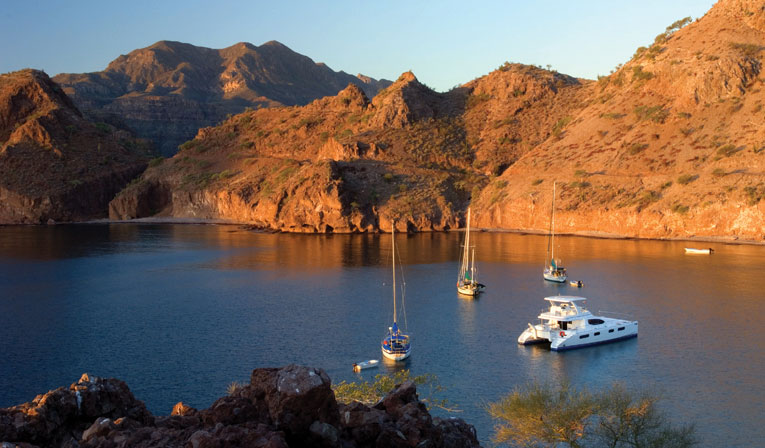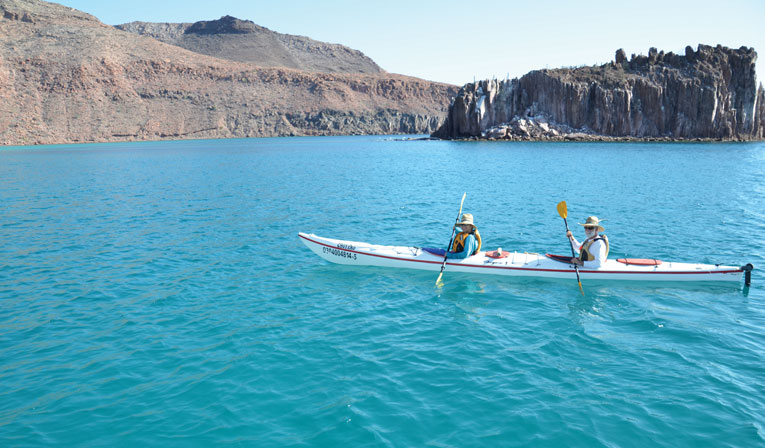Photo by Bing O’Meara
Escape pressures of everyday life and find a renewed sense of peace and tranquility in Mexico’s Sea of Cortez
If there was ever a time to get away for a spell, this is it. At home in the U.S., we’re dealing with a recession that won’t go away. We are in political turmoil, split down the middle; one half diametrically opposed to the other. Watch the news on television, and what you get is an opinion, usually the flip side of the one you hold.
We’ve shipped our jobs overseas and have an unemployment rate above nine percent, even as high as 17 percent in some regions of the country. As a result, our nation of consumers are no longer consuming, and our middle class is hanging on by a thread. People are afraid and uptight, with very little light at the end of the tunnel.
So how do you cope? Get out of town! Go somewhere people are not obsessing over things they cannot control.
Where do you go for some relief? Mexico. Specifically, the islands of the Sea of Cortez. That’s what we did, and what I would recommend for you if you’re feeling bottled up, unable to sleep, drinking Maalox by the quart, and making yourself sick every time you glance at the Dow Jones on your iPhone.
So, how do you get started on your adventure? First of all, dump technology. You won’t need it. I didn’t see anyone with an iPad or an iPhone. In the eight days we were there, I didn’t even see a newspaper. Sometimes, it’s nice to not know what’s going on. The criteria for getting away shouldn’t be where other people go; you want to get away from people like yourself. Go where the animals and fish go. This train of thought began as tongue in cheek; however, the more I get into it, the more I believe I’m actually onto something.
Linda and I were presented with an opportunity to charter a 47-foot Power Catamaran through The Moorings charter base in La Paz, Mexico, which is located at Costa Baja Marina. This is a beautiful place. After checking out of our hotel, we went to The Moorings office, which was located on site. We went through a briefing on itineraries, places not to miss, what was expected of us and what we could expect. We then moved to the boat for an orientation and walk-through.

Photo courtesy of The Moorings
Longing for La Paz
 By Heather Steinberger
By Heather Steinberger
As writer Bruce Berger notes in his acclaimed 1998 book “Almost an Island,” most written work about Mexico’s Baja California peninsula has focused on the region’s natural wonders.
With more than 30 species of marine mammal and 500 species of fish making their homes here, the peninsula’s Pacific and Gulf of California waters offer world-class scuba diving, snorkeling, sea-kayaking, whale-watching, fishing and recreational boating.
And then there’s the otherworldly Sonoran Desert, with its banded volcanic mountains, oddly green high sierra, hidden box canyons and sweeping arroyos. The landscape proves to be a haven for mountain bikers, backpackers, hikers, RVing families, ATV devotees and those intrepid explorers bound for the celebrated Sierra de San Francisco cave paintings with local guides and mules.
They’re all coming to experience “Baja” — that unique place of unparalleled adventure, a stunning natural juxtaposition where the desert tumbles to meet the tropical sea.
This Baja, however, is what Berger calls a hard-edged mirage. To truly experience the heart and soul of this place, you need to get to know its people.
“To approach the goal of conjuring the peninsula whole in my mind,” Berger writes of his own travels in the region, “I needed to pass through Baja to Baja California.”
The best way to discover the real Baja California is to spend a few days in La Paz, capital of the Mexican state of Baja California Sur. Located just 100 miles north of the more famous Los Cabos corridor, this bustling, friendly seaport has managed to retain its laid-back, muy tranquilo character even in the face of increasing development and a population explosion.
Brightly painted colonial architecture adorns the historic centro with its narrow zigzag streets, and the waterfront resembles a seaside European boulevard with its five-kilometer-long malecon seawall promenade, open-air restaurants, sidewalk cafes and venerable hotels.
A modest fleet of colorful fishing pangas rests on the beach, with fishermen ready to supply fresh seafood to the city’s myriad restaurants and taco stands or to carry visitors to see whale sharks in the bay, to swim with sea lions at the Los Islotes colony or to explore Isla Espíritu Santo, a UNESCO World Heritage Site and Biosphere Reserve north of the city.
First tip: Stay in town, perhaps at the Seven Crown, the Hotel Perla or El Moro. The city’s centro is quite walkable, and its vibe will enchant you.
Second tip: Rent a car so you can enjoy the many pleasures just a short drive away. Don’t worry about parking; at most public lots, 20 pesos — less than $2 — will buy unlimited time.
Enjoy your morning cup of coffee and a plate of huevos rancheros or chilaquiles at Hotel Perla’s La Terraza restaurant, a gracious, open-air, waterfront establishment. Or, if you prefer to make your own coffee, visit Ramón at Cafe Batalla, just past the intersection of Calle Zaragoza and Avenida Independencia. Ask for “dos molinas, revuelto,” and savor the flavors of Veracruzean coffee.
Drive 10 kilometers to Playa Balandra, near the tip of the Pichilingue Peninsula, and hike around the northern rim of the bay; a delightful, hidden beach with sugar sand and turquoise water is just around the corner, adorned with La Paz’s iconic “mushroom rock.” While crowds can be heavy on weekends, you might be the only one there on a midweek morning.
Stop at Playa Tecolote, which faces the San Lorenzo Channel and Isla Espíritu Santo. The surf might be up, the water will be warm, and the fish tacos are nothing short of spectacular at the beach restaurant.
Or take a drive down to Bahía de Los Muertos, more recently christened Bahía de Los Sueños — “dreams” is apparently easier to promote than “the dead.” Despite new home development and a nearby golf course, you likely will have the beach to yourself, with only the local fishing pangas and a few cruising sailboats for company.
Photo courtesy Fun Baja
Photo courtesy of Wikipedia Commons
Tom, a captain for The Moorings, went through all the boat systems: Water, plumbing, electrical, how everything worked. The boat itself was spotless and spacious, with its 47-foot length, 25-foot beam and 4½-foot draft. You’ll spend almost no time tied up at the dock, except for a short stint at home base. Once underway, you can expect anchoring out in magnificent coves with white sugar-sand bottoms.
Los Islotes is famous for its sea lion rookery. Snorkelers and scuba divers have been frequenting these rocky outcroppings for years to experience swimming with sea lions and their pups.
Los Islotes are two islets connected by an awash reef with depths down to 60 feet. Because of the depth and rocky bottom, I did not want to drop anchor.
Linda insisted she wanted to experience swimming with the sea lions. I backed the boat as close as I thought safe, and Linda dove in. She swam with the pups until an 800-pound male slid off his rock; it was time to climb back aboard.
The Sea of Cortez offers unlimited experiences you can take advantage of, whether you’re chartering or simply looking to explore the region. Sea & Adventures Inc. is a sea kayak and whale watching eco-tour outfitter. Their expeditions along the coast and islands between La Paz and Loreto Bay National Marine Park have been highlighted as the “ultimate Baja California kayaking safari” by National Geographic Adventure magazine. Their expeditions range from self-supported for the more adventurous to skiff-supported expeditions, adding comfort and luxury to your adventure.
We crossed paths with people who were just finishing their fourth kayaking camping trip with Sea Adventures, and could not say enough good things about their experience.
Another option for adventure is Fun Baja, a tour company that can provide an individualized tour package to meet your needs. They offer combination diving and camping trips, scuba certification programs from beginner to advanced, snorkeling with sea lions, as well as whale watching, kayaking and land tours, which take you inside the rustic charm of the Baja peninsula.

Photo by Bing O’Meara
Most of the islands you’ll visit are unpopulated, although there are a few small fishing villages such as San Evaristo, a colorful little island with burros walking the beach, a cantina and a couple of ex-pat liveaboards who’ve made this place home. If you lived aboard and had no debt, you could probably do quite well — assuming you really liked fish.
The people here are warm and friendly with a sense of community that I envy. The casual dress code includes shorts, flip-flops and maybe a shirt.
One evening we anchored off the northern end of Isla San Francisco, a beautiful white sandy beach. After dropping the anchor and settling in, one-quarter-mile off our stern we noticed a small rocky island with rustic houses perched atop. We looked up the island in our cruising guide, “Isla Coyote (Pardito),” and it said that visitors were welcome. The next morning, we launched the dingy and headed over.
As we approached the island, three gentlemen standing on the beach waved us in. We introduced ourselves to Manuel “Chacho” Curvas Dias (uncle), Jesus Ismael Curvas Collins (nephew) and Kevin Martin of Vancouver, Washington, a visiting friend. Fortunately, Kevin acted as our translator for the evening; without him, conversation would have been impossible due to the language barrier.
Manuel’s father made the island home. At one point, they had 40 people living there. The island had a school, and a teacher would come daily to teach.
Today, they fish. This day they had an order for 90 large clams. Local fishermen fish out of their “pangas,” boats specially designed for the Sea of Cortez that are 26 feet long by 5 feet wide by 3½ feet deep. After a tour of the island, Linda invited the men over to our catamaran for drinks later that evening. At 8 p.m., they were tying off their panga and coming aboard.
Chacho explained how he loved living on the island and how much more interesting it was than living in La Paz. He said he got to meet people from all over the world. Jacques Cousteau had been to the island, as well as Chuck Yeager and many others. He said Cousteau really loved the Sea of Cortez, calling it the “aquarium of the world.”
The landscape has been described by some as lunar. If you include the sun in the mix — the brightest I’ve ever seen — and the crystal-clear turquoise water, the combination ignites. The breeze is constant; the night sky heavenly. It is truly a magnificent, otherworldly place.
Cruising Resource
 “Sea of Cortez: A Cruiser’s Guidebook”
“Sea of Cortez: A Cruiser’s Guidebook”
$49.95 USD
320 pages, full color, spiral-bound
Blue Latitude Press LLC
P.O. Box 2773
Kirkland, WA 98083-2773
360-421-1934
info@exploringcortez.com
www.exploringcortez.com





